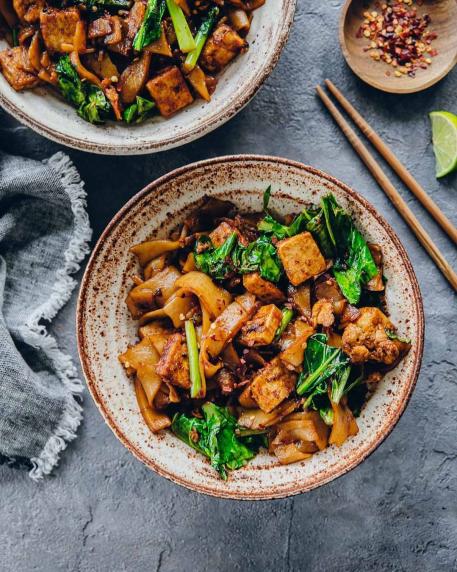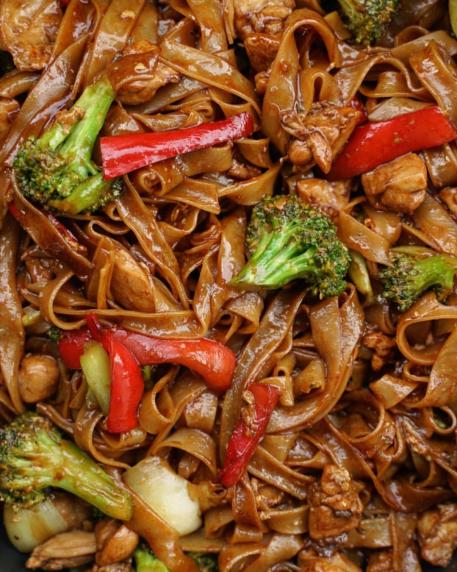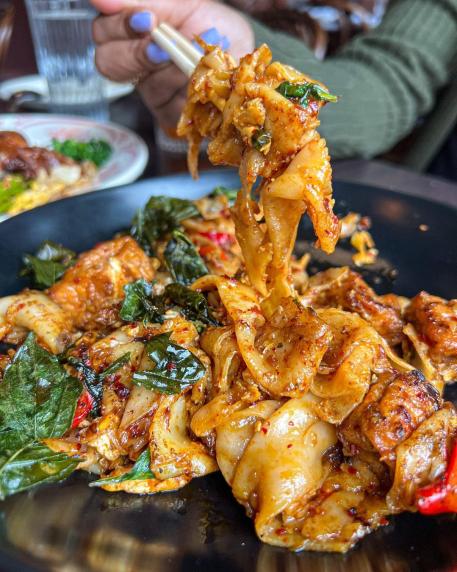Pad See Ew is a popular Thai dish that has gained a loyal following worldwide. As someone who enjoys trying different cuisines, I was intrigued to learn about the nutritional content of this dish.
As I began to research Pad See Ew calories, I was surprised to discover the wide range of calorie counts and factors that influence them. In this article, I will share what I’ve learned about the nutritional value of Pad See Ew, as well as tips for enjoying this tasty dish while still maintaining a healthy lifestyle.
What is Pad See Ew?

Pad See Ew is a popular Thai dish that typically consists of wide, flat rice noodles stir-fried with Chinese broccoli, soy sauce, and a choice of protein such as chicken, beef, or shrimp. Other common ingredients include egg, garlic, and sweet soy sauce.
Traditionally, Pad See Ew is cooked over high heat in a wok, which gives the dish its signature smoky flavor. The noodles are briefly soaked in warm water before being added to the pan with the other ingredients.
Variations of Pad See Ew can be found across Thailand and Southeast Asia, with different regions and restaurants offering their own unique twists on the dish. Some variations may include additional vegetables, spices, or sauces, while others may use different types of noodles or meats.
Despite its regional variations, Pad See Ew has become a beloved staple of Thai cuisine both in Thailand and around the world.
While many people enjoy the taste of Pad See Ew, its high-calorie content has become a concern for those watching their weight or trying to maintain a healthy lifestyle. This article focuses on the nutritional content of Pad See Ew and provides information and tips for enjoying this dish in moderation.
Maybe you need to know: Pad See Ew vs Drunken Noodles: Is Pad See Ew Drunken Noodles?
How many calories Pad See Ew?

The number of calories in Pad See Ew can vary widely depending on factors such as the cooking method, serving size, and choice of protein.
A typical serving of Pad See Ew made with chicken or beef contains around 500-700 calories, while a shrimp version may contain slightly more.
The dish’s macronutrient breakdown usually consists of high levels of carbohydrates from the noodles and vegetables, moderate amounts of protein from the meat or seafood, and a small amount of fat from the cooking oil.
The recommended serving size for Pad See Ew is usually around 1-2 cups, depending on the recipe and personal preference.
When it comes to calories per serving, Pad See Ew can range from around 400 calories for a smaller portion with fewer ingredients to over 1,000 calories for a larger serving or a version with additional high-calorie ingredients. It’s important to be mindful of portion size and the calorie content of the ingredients when enjoying this dish.
How many average Pad See Ew calories?
The average Pad See Ew calories can vary depending on several factors, such as the cooking method and ingredients used. However, a typical serving of Pad See Ew made with chicken or beef and served in a restaurant can contain anywhere from 500 to 700 calories. This makes it a higher calorie option compared to some other popular Thai dishes such as Tom Yum soup or papaya salad.
When comparing Pad See Ew calories to Western dishes, the numbers can be quite surprising. For example, a typical serving of spaghetti carbonara contains around 1,000 calories, while a cheeseburger with fries can easily reach 1,200 calories or more. This means that Pad See Ew can be a relatively healthier option compared to some Western fast food dishes.
It’s important to note, however, that the calorie content of Pad See Ew can still be high if portion sizes are large or if the dish is made with higher-calorie ingredients such as pork belly or extra oil. It’s always a good idea to check the nutritional information or ask the restaurant for details on the ingredients used when ordering Pad See Ew or any other dish.
How many low-calorie Pad See Ew calories?
Low calorie Pad See Ew options are available for those looking to enjoy this dish while keeping their calorie intake in check. By making some adjustments to the recipe, such as using less oil, opting for a leaner protein source like chicken breast, and adding more vegetables, it’s possible to significantly reduce the calorie count of this dish.
A typical low-calorie Pad See Ew recipe may contain around 250-350 calories per serving, which is significantly lower than the traditional version. However, it’s important to note that the actual calorie count can vary depending on the specific recipe and serving size.
By choosing a low-calorie Pad See Ew option, you can still enjoy the flavors and textures of this classic Thai dish without consuming an excessive amount of calories. It’s a great way to indulge in your favorite cuisine while staying on track with your health goals.
How many calories of Pad See Ew when eaten with other dishes?
The number of calories in Pad See Ew when eaten with other dishes can vary depending on the specific dishes chosen and the portion sizes consumed.
On its own, a serving of Pad See Ew can contain around 500-700 calories per cup, depending on the recipe and ingredients used. If eaten alongside other high-calorie dishes such as fried rice or curry, the overall calorie count can quickly add up.
Pad see ew calories chicken
When it comes to the choice of protein in Pad See Ew, chicken is a popular option that can offer lower calorie counts compared to beef or shrimp. A serving of Pad See Ew made with chicken, is 500–700 calories per serving
Pad see ew calories tofu
Pad See Ew calories tofu can vary depending on the recipe and serving size. However, as tofu is a relatively low-calorie protein source compared to meat, a Pad See Ew with tofu may contain fewer calories than versions made with chicken, beef, or shrimp.
On average, a serving of Pad See Ew with tofu may contain around 350–500 calories, depending on the recipe and serving size. However, it’s important to note that the calorie count can vary depending on the amount of oil and other high-calorie ingredients used in the recipe.
For those looking for a low-calorie option, choosing Pad See Ew with tofu can be a great way to enjoy this dish without consuming an excessive amount of calories. Tofu is also a good source of plant-based protein and is lower in saturated fat than some meat options, making it a healthier choice for those looking to maintain a balanced diet.
Pad see ew calories vegan
For those following a vegan or plant-based diet, Pad See Ew calories vegan can be made without animal products by using tofu or vegetables as a protein source. A vegan Pad See Ew dish may contain around 350–550 calories per cup, depending on the recipe and ingredients used.
Pad see ew calories beef
The number of calories in Pad See Ew with beef can vary depending on the recipe and serving size. Here are some estimates for different dishes:
- Homemade Pad See Ew with beef (1 cup): around 500–700 calories
- Restaurant-style Pad See Ew with beef (1 cup): around 700–900 calories
- Low-calorie Pad See Ew with beef (1 cup): around 250–350 calories
Factors that affect pad see ew calories
Several factors can affect the calorie count of Pad See Ew, including the cooking method, type and amount of oil used, and the choice of protein. Here’s a closer look at each factor:
Cooking method
Traditional Pad See Ew is stir-fried over high heat in a wok, which can cause the noodles and other ingredients to absorb more oil and increase the calorie count. However, there are healthier cooking methods such as baking or grilling that can reduce the amount of oil used.
Type and amount of oil used
The oil used to cook Pad See Ew can significantly affect the calorie count. Some recipes call for generous amounts of oil, which can quickly increase the calorie count. Using a smaller amount of oil or opting for healthier oils like olive oil or coconut oil can help reduce calories.
Choice of meat
The choice of protein used in Pad See Ew can also affect its calorie count. Chicken, beef, and shrimp are the most common protein sources, but some versions may include pork, duck, or other meats. Choosing leaner meats and reducing the portion size can help cut down on calories.
How to eat Pad See Ew on a diet?

If you’re on a diet but still want to enjoy Pad See Ew, there are ways to incorporate this dish into a healthy eating plan. Here are some tips:
Incorporating Pad See Ew into a healthy diet plan
One way to enjoy Pad See Ew while on a diet is to make it yourself at home. This way, you can control the ingredients and cooking methods to make it more calorie-friendly. Using lean protein sources like chicken breast or tofu, increasing the number of vegetables, and reducing the portion size can all help make the dish healthier.
Tips for tracking calorie intake
To stay on track with your diet, it’s important to track your calorie intake. There are several apps and websites that can help you keep track of your calorie and macronutrient intake. You can also use a food scale to weigh out your portion sizes and keep track of how much you’re consuming.
Strategies for eating out at Thai restaurants
If you’re dining out at a Thai restaurant, there are still ways to enjoy Pad See Ew while keeping your diet in mind. Ask for a smaller portion size or request that the dish be made with less oil.
You can also substitute the protein source with tofu or vegetables. Be mindful of other high-calorie dishes and limit your intake of other items like fried appetizers or sugary drinks.
Tips for balancing Pad See Ew with exercise
If you’re looking to balance Pad See Ew with exercise, here are some tips:
Choose your serving size wisely
While Pad See Ew can be a filling and satisfying meal, it’s important to be mindful of your portion size. A smaller serving size can help keep your calorie intake in check, leaving you with energy for exercise.
Time your meal appropriately
Depending on the intensity of your workout, you may want to eat Pad See Ew a few hours before or after exercising. Eating too close to a workout can make you feel sluggish, while waiting too long after a workout can leave you feeling depleted.
Pair Pad See Ew with other nutrient-rich foods
To balance out the high-carbohydrate content of Pad See Ew, consider pairing it with other nutrient-rich foods like a salad or roasted vegetables. This can help provide your body with the nutrients it needs to fuel your exercise routine.
Drink plenty of water
Staying hydrated is essential for exercise, and it can also help you feel full and satisfied after eating Pad See Ew.
What are alternative ingredients?
If you’re looking for alternative ingredients for Pad See Ew, here are some options:
- Tofu: Tofu is a great alternative protein source for those who prefer a plant-based diet or want to reduce their meat consumption. It can be used in place of chicken, beef, or shrimp in Pad See Ew recipes.
- Broccoli: While Chinese broccoli is the traditional vegetable used in Pad See Ew, regular broccoli can also be used as an alternative. It’s a good source of fiber and vitamins, and adds a nice crunch to the dish.
- Zucchini: Zucchini is another vegetable that can be used in place of Chinese broccoli in Pad See Ew. It’s low in calories and high in nutrients, making it a great choice for those looking for a healthier alternative.
- Carrots: Adding carrots to Pad See Ew can help boost the dish’s nutritional content. They’re a good source of beta-carotene and fiber, and can add a pop of color to the dish.
- Shirataki noodles: Shirataki noodles are made from konjac root and are a great alternative for those looking to reduce their carbohydrate intake. They’re very low in calories and can be used in place of traditional rice noodles in Pad See Ew.
Using these alternative ingredients, you can create a Pad See Ew dish that fits your dietary needs and preferences while still enjoying the flavors and textures of this popular Thai dish.
What are healthy cooking methods with Pad See Ew?
Here are some healthy cooking methods for Pad See Ew:
- Baking: Instead of stir-frying the noodles and vegetables in a wok, you can bake them in the oven to reduce the amount of oil used. Simply toss the ingredients with a small amount of oil and bake them at a high temperature until they’re cooked through.
- Grilling: Grilling the chicken or beef used in Pad See Ew is a great way to reduce the amount of oil used and add a smoky flavor to the dish. You can also grill the vegetables separately before adding them to the noodles.
- Boiling: Another healthy cooking method for Pad See Ew is boiling the noodles and vegetables before adding them to the pan. This can help reduce the amount of oil needed to cook the dish.
- Stir-frying with a non-stick pan: If you prefer to stick with the traditional stir-fry method, consider using a non-stick pan to reduce the amount of oil needed. You can also use a cooking spray instead of oil to further reduce the calorie count.
What does the Pad See Ew health benefits and risks?

Benefits of Pad See Ew ingredients
Pad See Ew can offer several health benefits due to its combination of nutritious ingredients. Here are some of the benefits:
- Vegetables: Chinese broccoli and other vegetables used in Pad See Ew are rich in fiber, vitamins, and minerals, which can support digestive health and overall well-being.
- Protein: The protein source used in Pad See Ew, whether it’s chicken, beef, or tofu, can provide essential amino acids needed for muscle growth and repair.
- Noodles: The rice noodles used in Pad See Ew are a good source of carbohydrates, which can provide energy for physical activity and help regulate blood sugar levels.
Risks of Pad See Ew
However, consuming too much Pad See Ew can also have potential risks. Here are some things to keep in mind:
- High-calorie count: Traditional Pad See Ew can be high in calories due to the use of oil and high-calorie ingredients. Consuming too many calories can lead to weight gain and other health issues.
- High sodium content: Some Pad See Ew recipes may contain high amounts of sodium, which can contribute to high blood pressure and other health problems.
FAQs
Can I eat Pad See Ew on a low-carb diet?
If you’re following a low-carb diet, traditional Pad See Ew may not be the best choice. The dish typically contains rice noodles, which are high in carbohydrates.
However, there are some ways to modify the recipe to make it more low-carb-friendly. Here are some tips:
- Substitute the noodles: Instead of rice noodles, you can use alternative noodles like shirataki noodles or zucchini noodles. These options are lower in carbohydrates and can still provide a similar texture and flavor.
- Use more protein and vegetables: By increasing the amount of protein and vegetables in the dish, you can help balance out the carbohydrate content. Choose lean protein sources like chicken or tofu and load up on non-starchy vegetables like broccoli or mushrooms.
- Control your portion size: Even with modifications, Pad See Ew can still be calorie-dense. Be mindful of your portion size and aim to stick to recommended serving sizes.
With these modifications, you can still enjoy Pad See Ew while following a low-carb diet.
What are the macronutrient breakdowns of Pad See Ew?
The macronutrient breakdowns of Pad See Ew can vary depending on the recipe and ingredients used. Generally, Pad See Ew is a high-carbohydrate dish due to the use of rice noodles, with moderate amounts of protein and fat.
What is the recommended serving size of Pad See Ew?
Here’s an example breakdown for a serving size of 1 cup (150 grams) of Pad See Ew with chicken:
- Calories: 302
- Carbohydrates: 44 grams
- Protein: 15 grams
- Fat: 6 grams
It’s important to note that the calorie count and macronutrient breakdowns can vary based on the recipe and portion size.
A recommended serving size of Pad See Ew is around 1 cup (150 grams), which is typically enough to fill a small bowl. It’s important to be mindful of your portion size, as larger servings can quickly increase the calorie count.
Can Pad See Ew be frozen?
Yes, Pad See Ew can be frozen for later consumption. To freeze Pad See Ew, let it cool to room temperature, then transfer it to an airtight container or freezer bag.
When you’re ready to eat it, thaw the Pad See Ew in the refrigerator overnight. Reheat it in the microwave or on the stove, adding a splash of water or broth to prevent it from drying out.
How long does Pad See Ew last in the fridge?
In the fridge, Pad See Ew can last for 3–4 days if stored properly in an airtight container. It’s important to reheat the Pad See Ew to an internal temperature of 165°F (74°C) before consuming it to prevent foodborne illness. If the Pad See Ew has been left at room temperature for more than 2 hours, it’s best to discard it.
What is the difference between Pad See Ew and Pad Thai?
Pad See Ew and Pad Thai are both popular Thai noodle dishes, but there are some key differences between them.
- Pad See Ew is typically made with wide, flat rice noodles, Chinese broccoli or other leafy vegetables, and a protein such as chicken, beef, or shrimp. The dish is flavored with soy sauce, fish sauce, and oyster sauce, and often includes garlic and black pepper.
- Pad Thai, on the other hand, is made with thin rice noodles, eggs, tofu, bean sprouts, and a protein such as chicken or shrimp. It’s flavored with tamarind paste, fish sauce, and sugar, and often includes peanuts and lime wedges as toppings.
While both dishes can be high in calories and carbohydrates, Pad See Ew tends to be slightly lower in sugar than Pad Thai. The two dishes also have different flavor profiles, with Pad See Ew having a slightly sweeter, savory taste and Pad Thai having a tangy, sweet and sour taste.
Does Pad See Ew gluten-free?
As for gluten, traditional Pad See Ew is not gluten-free due to the use of soy sauce and oyster sauce, both of which can contain gluten. However, it’s possible to make gluten-free Pad See Ew by using gluten-free soy sauce and oyster sauce, or by substituting other sauces with gluten-free alternatives.
Related: Is Pad Thai Gluten Free?
How much sugar is in Pad See Ew?
The amount of sugar in Pad See Ew can vary depending on the recipe and ingredients used. However, traditional Pad See Ew is typically low in sugar, with most of its sweetness coming from the soy sauce and oyster sauce used to flavor the dish. Depending on the recipe and serving size, Pad See Ew may contain anywhere from 2 to 8 grams of sugar per serving.
How can I reduce the sodium content in Pad See Ew?
If you’re looking to reduce the sodium content in Pad See Ew, here are some tips:
- Use low-sodium soy sauce: Soy sauce is a major source of sodium in Pad See Ew, so opting for a low-sodium variety can significantly reduce the dish’s sodium content.
- Use less sauce: Using less soy sauce, oyster sauce, or other high-sodium sauces can help reduce the dish’s overall sodium content.
- Use salt substitutes: Instead of using salt to season the dish, try using salt substitutes like herbs, spices, or vinegar to add flavor without adding sodium.
- Increase the amount of vegetables: Adding more non-starchy vegetables like Chinese broccoli or mushrooms to the dish can help dilute the sodium content and add extra nutrients.
Conclusion
Bluntly stated, Pad See Ew can be a delicious and satisfying dish to enjoy as part of a healthy diet. With its combination of flavorful ingredients, it’s no wonder this dish has become a favorite for so many.
By understanding the factors that influence Pad See Ew calories and making conscious choices about portion size and cooking methods, it’s possible to enjoy this dish without derailing your health goals.
Whether you’re looking to indulge in a high-calorie version or prefer to opt for a low-calorie alternative, Pad See Ew can fit into a balanced diet with moderation and mindfulness. So go ahead and savor the flavors of Pad See Ew, while keeping an eye on your overall calorie intake.